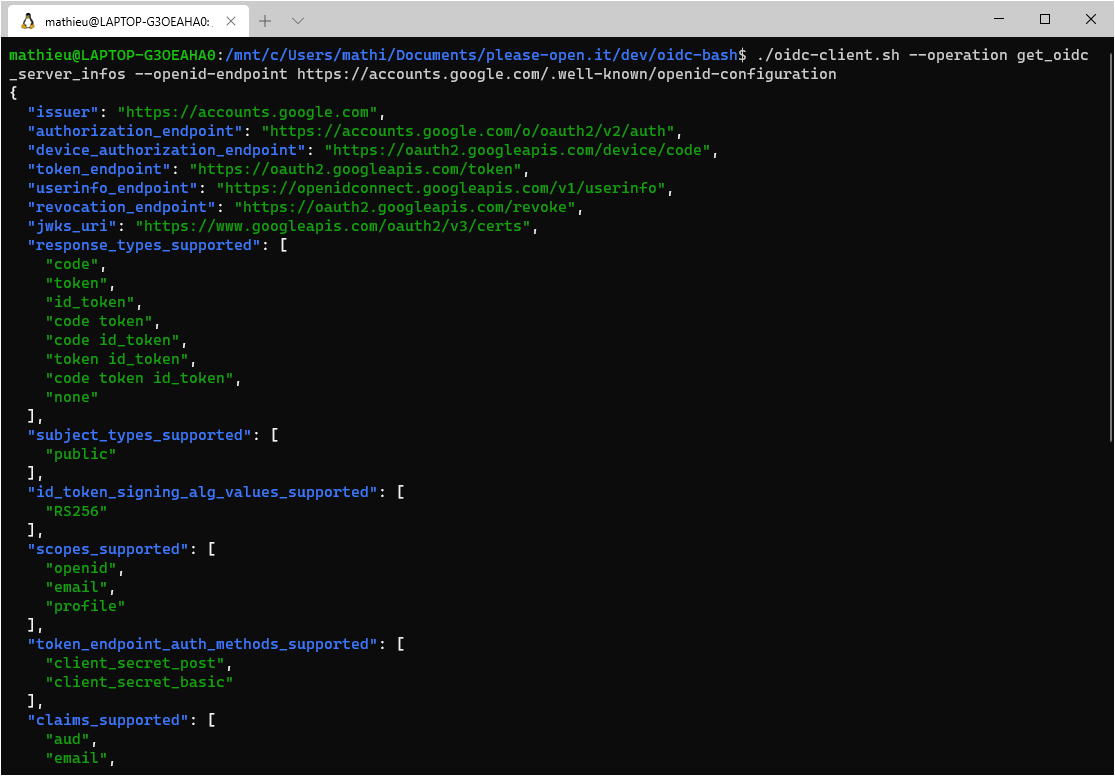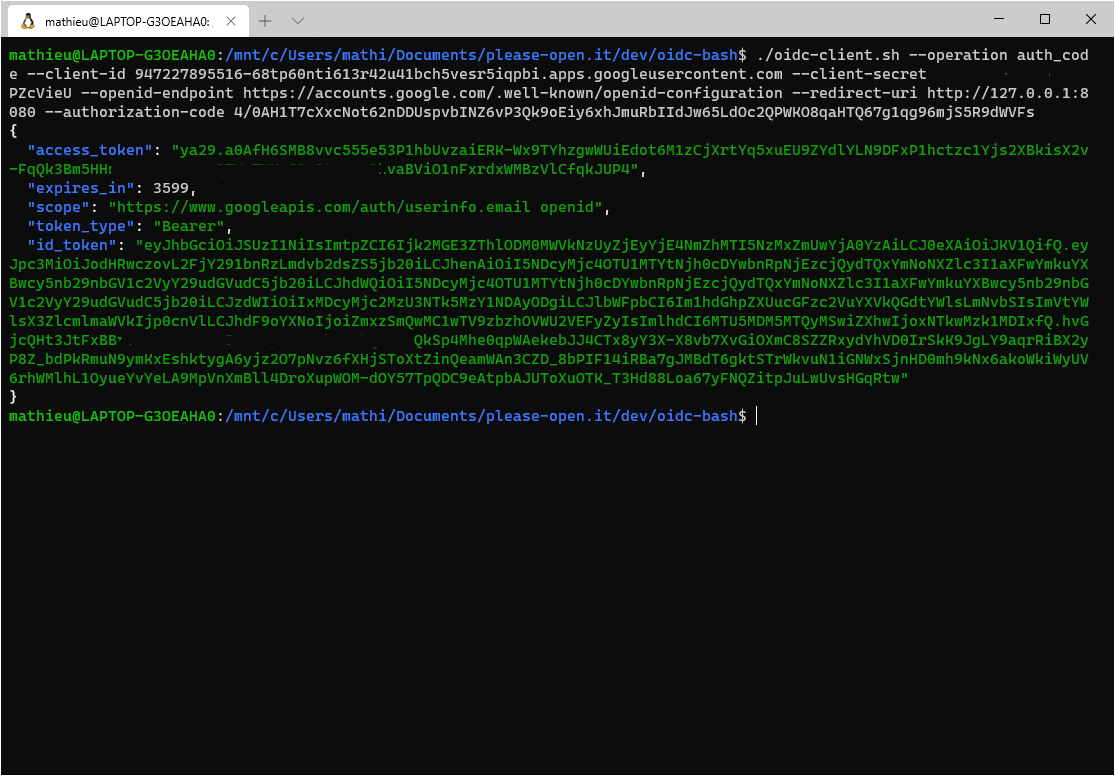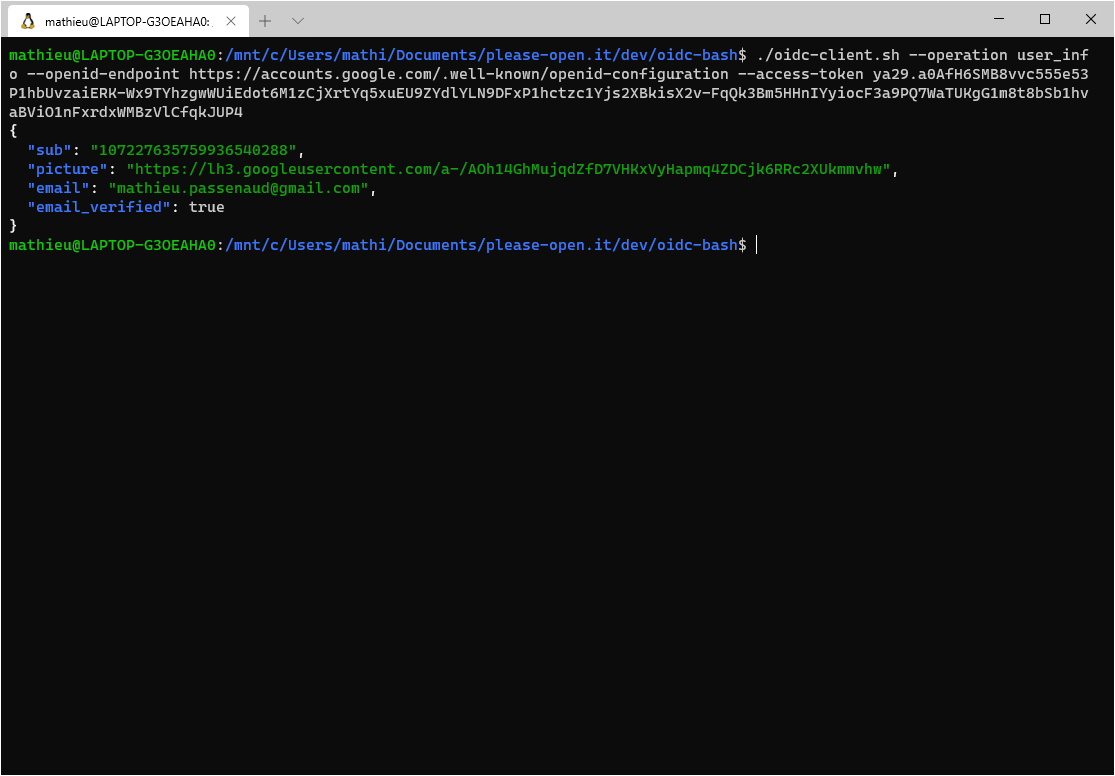please-open.it specializes in authentication and web security, and provides Keycloak as a service.
This bash script is an oauth2 wrapper. You can make any authentication request from command line with the right arguments.
Supported operations are :
- get oidc server infos
- client credentials
- implicit flow
- authorization code flow
- resource owner password
- auth code exchange
- token exchange
- refresh token
- end session
- token introspection
- user infos
- device code
- poll token
Use it as a guide for oauth2/openid connect discovery or in any testing/integration process. Script is totally stateless, save the output of a command in variables to reuse tokens.
You need curl, jq and netcat installed.
Note : on Debian, install netcat-openbsd version
apt-get install netcat-openbsd
Google is an OpenIdConnect provider, you can get the discovery document at https://accounts.google.com/.well-known/openid-configuration
./oidc-client.sh --operation get_oidc_server_infos --openid-endpoint https://accounts.google.com/.well-known/openid-configuration
*Using authorization_code_grant process, a standard for the web supported by all providers, you can get a new token from an authorization_code. To get a new authorization_code,
./oidc-client.sh --operation authorization_code_grant --client-id 947227895516-68tp60nti613r42u41bch5vesr5iqpbi.apps.googleusercontent.com --openid-endpoint https://accounts.google.com/.well-known/openid-configuration --redirect-uri http://127.0.0.1:8080 --scope email
Then the console shows :
OPEN THIS URI IN YOUR WEB BROWSER
https://accounts.google.com/o/oauth2/v2/auth?client_id=947227895516-68tp60nti613r42u41bch5vesr5iqpbi.apps.googleusercontent.com&scope=email&response_type=code&response_mode=fragment&redirect_uri=http://127.0.0.1:8080
-- LISTENING ON PORT 8080 FOR A REDIRECT
Open your web browser and paste the URI shown in the console. You will have a login screen then a consent screen. Afterthat, redirect process will show a page from 127.0.0.1:8080 with all given data. Get your authorization code.
Second step is exchanging an authorization_code for a token. The operation "auth_code" is designed for :
./oidc-client.sh --operation auth_code --client-id 947227895516-68tp60nti613r42u41bch5vesr5iqpbi.apps.googleusercontent.com --client-secret ****************** --openid-endpoint https://accounts.google.com/.well-known/openid-configuration --redirect-uri http://127.0.0.1:8080 --authorization-code 4/0AH1T7cXxcNot62nDDUspvbINZ6vP3Qk9oEiy6xhJmuRbIIdJw65LdOc2QPWKO8qaHTQ67g1qg96mjS5R9dWVFs
using the access_token we got previously :
Of course ! Keycloak has its own discovery document (for a realm) with the "OpenID Endpoint Configuration" link. Keycloak supports all operations of this bash script, please refer to the documentation links for each operation below.
Feel free to test it with a realm you can get at https://realms.please-open.it.
Each operation output some formatted JSON code. By using --field argument, you can filter the output with JQ grammar.
https://openid.net/specs/openid-connect-discovery-1_0.html
Get oauth2 and openid connect endpoint locations using the discovery document.
--openid-endpoint
https://www.mathieupassenaud.fr/oauth-backend/
Perform client_credentials authentication request.
--openid-endpoint OR --token-endpoint
--client-id
--client-secret
https://oauthlib.readthedocs.io/en/latest/oauth2/grants/password.html
Make an authentication request with client credentials and user credentials.
--openid-endpoint OR --token-endpoint
--client-id
--client-secret (optionnal in case of public client)
--username
--password
--scope
Just log out the user by revoking tokens
--openid-endpoint OR --end-session-endpoint
--access-token
--refresh-token
--client-id
--client-secret (optionnal if client is public)
Renew an access_token using a refresh_token
--openid-endpoint OR --token-endpoint
--client-id
--client-secret (optionnal if client is public)
--refresh-token
https://www.mathieupassenaud.fr/token-exchange-keycloak/
Perform a token_exchange operation
--openid-endpoint OR --token-endpoint
--client-id
--client-secret
--access_token
--issuer
https://docs.microsoft.com/en-us/azure/active-directory/develop/v2-oauth2-implicit-grant-flow
FOR LEGACY APPLICATIONS ONLY
Initiate a connection by showing an URL you have to open using your local web browser.
Then, a local web server (using netcat) will respond with a single page showing tokens returned by the authentication server in the redirect_uri.
By default, redirect URI has to be http://127.0.0.1:8080, you can have your own web server for this usage.
--openid-endpoint OR --authorization-endpoint
--client-id
--redirect-uri
--scope
https://docs.microsoft.com/en-us/azure/active-directory/develop/v2-oauth2-auth-code-flow
Initiate a connection by showing an URL you have to open using your local web browser.
Then, a local web server (using netcat) will respond with a single page showing the authorization_code returned by the authentification server in the redirect_uri.
By default, redirect URI has to be http://127.0.0.1:8080, you can have your own web server for this usage.
--openid-endpoint OR --authorization-endpoint
--client-id
--redirect-uri
--scope
Change an authorization_code to a token
--openid-endpoint OR --token-endpoint
--client-id
--client-secret (optionnal for public clients)
--redirect-uri
https://www.oauth.com/oauth2-servers/token-introspection-endpoint/
Get details about a token
--openid-endpoint OR --token-introspection-endpoint
--client-id
--client-secret
--access-token
Get all user informations
--openid-endpoint OR --userinfo-endpoint
--access-token
Initiate a device_code flow
--openid-endpoint OR --device-authorization-endpoint
--client-id
--client-secret
Get a token (poll operation, renew if necessary), IE for a device_code flow
--openid-endpoint OR --token-endpoint
--client-id
--client-secret
--device-code


